Saturday
Arts and Poetry, Featured StoriesThe Milarepa Children’s Chorus
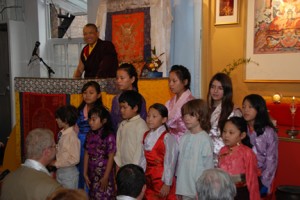
Milarepa Chorus performs for the Sakyong at the Shambhala Meditation Center of New York on September 28, 2008
Sometime in the mid-1980’s Khenpo Tsultrim Gyamtso Rinpoche was brought to the Kalapa Court in Boulder, Colorado for a brief informal meeting with Chogyam Trungpa Rinpoche. When Khenpo Rinpoche left, Trungpa Rinpoche remarked to his kusung, “A scholar and a yogi!” The Kusung asked, “Is that good, Rinpoche?” And Trungpa Rinpoche replied, “Very good.”
After that auspicious meeting and after Trungpa Rinpoche passed into parinirvana, many of his senior students began studying with Khenpo Rinpoche each summer at our land centers beginning in 1990, first at Shambhala Mountain Center in Colorado and then at Karme Choling in Vermont. In many ways Khenpo Rinpoche saved our lives because of the grief we felt with the loss of Trungpa Rinpoche. In addition, Khenpo Rinpoche began presenting advanced teachings on mahamudra that Trungpa Rinpoche, had he lived, would have taught us.
One of the unique ways in which Khenpo taught was through songs. These songs were handed down from the great Tibetan yogi Milarepa and other Kagyu lineage holders. Khenpo sang the songs in Tibetan and his translators translated them into English using western melodies. Khenpo Rinpoche’s dharma talks were frequently interspersed with singing and dancing. Khenpo Rinpoche said that we sing because one of the twelve ways the Buddha taught was through singing — The Teachings of Beautiful Melody. The doha tradition continued among the tantric siddhas of India to express their realization. These songs became an important teaching tool in the Kagyu tradition in Tibet as well.
I discovered that songs were a profound way to teach the dharma to children and young adults. I began using songs in my plays about the life of the Buddha and his family. Each time I would write a scene, one of Khenpo Rinpoche’s songs would pop into my head to accompany the scene. During rehearsals, I saw how the play and the songs transformed the children.
About the Milarepa Children’s Chorus
The Milarepa Children’s Chorus is a group of Western, Asian and Tibetan children living in New York City. We sing Milarepa songs as taught to us by Khenpo Tsultrim Gyamtso Rinpoche, meeting twice-monthly at the Shambhala Meditation Center of New York on Friday evenings. The program is free and open to anyone young or old who likes to sing. The children range from 5 – 14 years in age.
Butterlamp Offering Song
May the shinning light of this candle flame we offer,
To the ten directions, victors and their heirs.
Remove the darkness of all beings ignorance,
May the shinning light of knowledge and wisdom blaze.
by Khenpo Tsultrim Gyamtso Rinpoche
Class Format
Our class begins with formally entering the shrineroom while singing “The Butter Lamp Offering Song.” Our chorus director Paul Griffin and one chorus member light the shrine. We then form a circle and welcome in the Mother lineage (circling to the left) and the father lineage (circling to the right) by singing Tara songs and the Guru Rinpoche prayer. We then sit for a short time. We go over the meaning of the songs to rehearse that evening, and members of the chorus have an opportunity to ask questions. Each child has their own songbook, made up especially for the chorus.
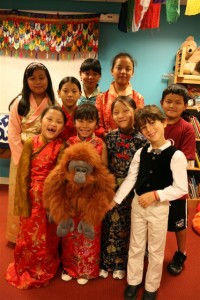
Chorus members with chorus mascot Coco Mila, performing at the The Rubin Museum in New York City. Photo by Jonne Chan
Songs As Offerings
The Chorus has had the opportunity to offer songs to visiting teachers at the Shambhala Meditation Center of New York. In New York, it is not unusual to attend a Shambhala Level and have twenty children come in and sing.
Once at Karme Choling, Khenpo Rinpoche asked the ladies to come up and dance while everyone sang a Milarepa song. I whispered to a friend sitting next to me that I wanted to dance but was too shy. She said, “See it as an offering to the guru.” That completely changed my view and the focus was not about me any more, but rather the sacredness of making offerings. When I share this story with the children, it helps them cut through their shyness as well.
Three Ways of Singing Songs
In class we talk about the many ways in which one can sing a song. For example, when we sing “The Butter Lamp Offering Song,” we can sing it as a sweet song or visualize hundreds of butter lamps being offered to the four directions. Or when we sing the Tara songs, we can visualize in the sky in front of us 21 Taras, their different colors, their qualities, and then ourselves as Tara, healing the fears of all sentient beings. One seven-year-old Tibetan girl told me she has been teaching the songs to her Bangladeshi classmate.
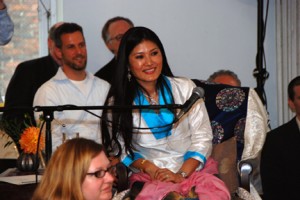
Sakyong Wangmo enjoying the Milarepa Chorus at the Shambhala Meditation Center of New York, September 28, 2008
Back to our Beginnings
The idea for the Milarepa Children’s Chorus was born on a cold Saturday afternoon in 2008 at the Shambhala Meditation Center of New York. That day, we were conducting a play rehearsal for Yasodhara, the story of Prince Siddhartha and his devoted wife Yasodhara. The play was to be performed for Vesak Day sponsored by The Buddhist Council of New York. Yasodhara had many Milarepa songs in it and, at this particular rehearsal, we had eight Tibetan children and a small group of western children whose parents were students of Khenpo Tsultrim Gyamtso Rinpoche. This was the first time since I started writing plays for Vesak Day that we had Tibetan children in the cast. On this particular afternoon, we were crammed into the Shambhala Training Office and I noticed how much the Tibetan children loved singing the Milarepa songs. I realized these songs were from their own culture, and they were in their bones so to speak. The western children had learned the songs from being at Khenpo Rinpoche’s programs with their parents and singing them at home. A big voice in my head said to start a Milarepa Children’s Chorus.
Permission Blessing
As soon as I got home, I contacted Khenpo Tsultrim Gyamtso Rinpoche in Seattle and asked his permission and blessing to start the Chorus. Khenpo said “yes” under two conditions: we should get a chorus director and ask Pora Tulku Rinpoche to help you. Pora Rinpoche is a close student of Khenpo Rinpoche, a Tibetan doctor whose three daughters were in the play. I then asked Paul Griffin, a member of the Shambhala Center with a background in music who loved singing Milarepa songs, to become our chorus director.
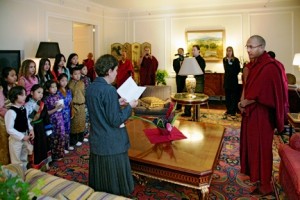
The Milarepa Chorus Performs for the 17th Gyalwang Karmapa’s visit to New York City, May 17 2008, Photo taken by James Gritz at the Waldorf Astoria
An Auspicious Dream Comes True
About five years ago, I dreamt that the Seventeenth Karmapa was sitting at a table with Traleg Kyabgon Rinpoche, my daughter Nicole Bryl, and me. The Karmapa was holding a Milarepa song book and singing songs to us. Five years later on Saturday morning May 17, 2008, the Milarepa Children’s Chorus had the great honor to offer three songs of realization at a private audience with the Karmapa at the Waldorf Astoria during the Karmapa’s first visit to New York.
The Milarepa Children’s Theater Performs Yasodhara
Yasodhara was part of the larger program for the Buddhist Council of New York’s annual Spring celebration of Vesak Day, the celebration of the Buddha’s birth, enlightenment and parinirvana. It had a cast of 38 children, teenagers and young adults. This was the third play I had written (beginning in 2001) for the children of the Buddhist Council – whose membership is made up of the diverse Buddhist meditation centers in New York City. Every Saturday afternoon we would gather at the New York Buddhist Vihara in Queens for play rehearsal. Sometimes we had rehearsal at the Shambhala Center for the actors who were from Shambhala and Nalandabodhi. This was the first time we had eight Tibetan children in the play. Our first play was Tangerine of Mindfulness about the early life of the Buddha as an ascetic and his encounters with children of his own time. The second play was Mahamaya, about the Buddha’s Mother and how she influenced the choices he made that led him to the path of awakening. The third play was Yasodhara, the story of Prince Siddhartha and his wife Yasodhara and how their love helped them to work with others in a very unique way.
Currently I am writing a play called Mahaprajapati, about the Buddha’s aunt who raised him and became the first Buddhist nun to be ordained by the Buddha. Mahaprajapati was also the sister of Mahamaya married to the same King. The play is the completion of a trilogy about the three most important and influential women in the Buddha’s life. It will be performed in 2009 at the Shambhala Meditation Center of New York.
For more information visit www.milarepachildrenstheater.com
View a video of the chorus singing on Children’s Day, December 14, 2008
[kml_flashembed movie="http://www.youtube.com/v/LJcjAu7NShk" width="425" height="350" wmode="transparent" /]

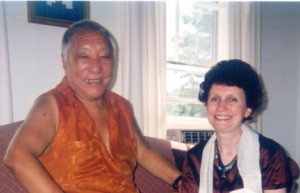
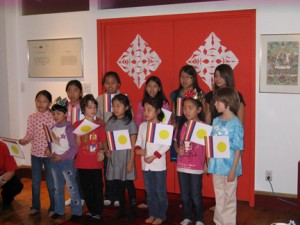
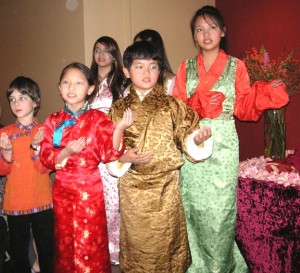
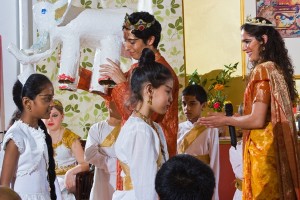




Nov 25, 2010
Reply
This was a treat ~ and was that Mr. Mauricio?